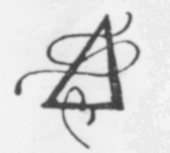Serapis Bey
Serapis Bey was an Adept who was the chief of certain Egyptian Brothers belonging to the "Ellora Section" of the Brotherhood of Luxor. He helped with the direction of the early work of the Theosophical Society, and was referred to as Maha Sahib.
General description
A. P. Sinnett mentions Serapis as being "with light hair, fair, and of great beauty,"[1] and "the youngest of the chohans."[2]
Despite of the young age of his body, Master Serapis is said to be among the highest Adepts – "One of the greatest of them" according to Colonel Olcott.[3] In 1883 the Colonel described him as:
The Teacher of our Teachers [Master K.H. and M.], a Paramaguru, as one such is called in India, and who had given me a small colored sketch of himself in New York, before we left for Bombay. . . ."[4]
The status of Master Serapis seems to be confirmed in some letters from the Masters of Wisdom, where he is mentioned by the name of "Maha Sahib".[5]
Letters to H. S. Olcott
Master Serapis Bey wrote at least 22 letters to Henry Steel Olcott published in Letters from the Masters of the Wisdom, Second Series. Most of these letters give Olcott guidance on how he could help Madame Blavatsky.
For a complete list, see Category:ML from Serapis Bey.
Online resources
Articles
- Serapis Bey at Theosopedia
- Master Serapis by Daniel Caldwell
Notes
- ↑ William Q. Judge, Letters That Have Helped Me, (Los Angeles:The Theosophy Company, 1946), 196.
- ↑ Vicente Hao Chin, Jr., The Mahatma Letters to A.P. Sinnett in chronological sequence No. 3a (Quezon City: Theosophical Publishing House, 1993), 10.
- ↑ Henry Steel Olcott, Old Diary Leaves First Series (Adyar, Madras: The Theosophical Publishing House, 1974), 237.
- ↑ Henry Steel Olcott, Old Diary Leaves Third Series (Adyar, Madras: The Theosophical Publishing House, 1974), 430-431.
- ↑ C. Jinarajadasa, Letters from the Masters of the Wisdom Ser. 2, No. 27 (Adyar, Madras: The Theosophical Society, 1977), 68.
